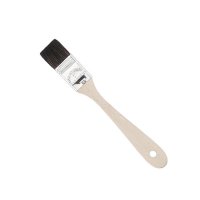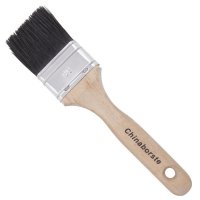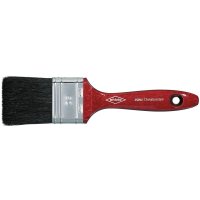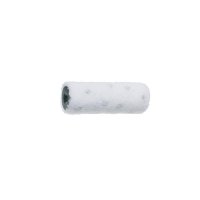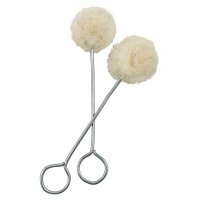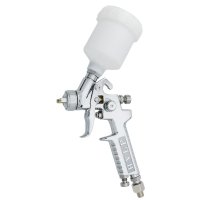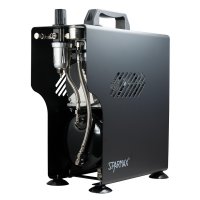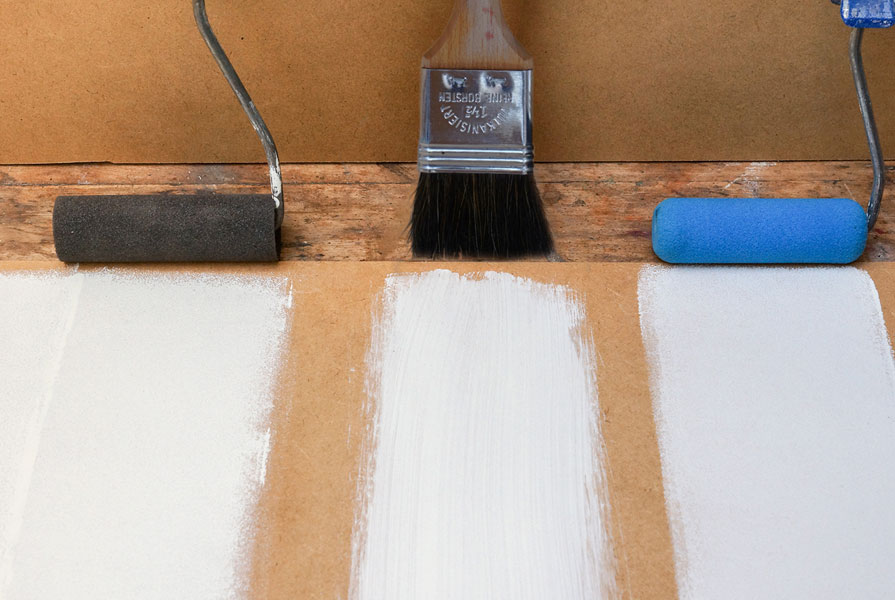
After finally deciding on a suitable surface agent, the next question immediately arises: what do I use to apply it best and how? Restorer and course instructor Melanie Kirchlechner will introduce you to the different application tools and give you tips for the optimal surface finish.
Theoretically, most liquid surface agents can not only be painted, but wiped, rolled, dipped or sprayed on. The aim is always to treat or coat a wooden surface evenly, preferably without visible marks. In practice, the viscosity and the respective flow behaviour of the agent play a major role in choosing the appropriate application device. If an agent is too viscous, brushes and sponges can cause streaks, rollers produce bubbles and sprayers »orange peel«. But the size, shape and accessibility of the wood surface to be treated also play a role. Small objects, for example, can be painted more effectively with a narrow brush or sponge cut to size than with a roller or sprayer. To make the decision easier, we present the individual application devices here. Most of them can be found at DICTUM under the shop category Brushes / Accessories.
Brushes
With a brush, liquid substances are worked directly into the structure or fibres of the wood surface. Compared with viscous liquids, brushes spread low-viscosity liquids more easily and leave no marks. Profiled and hard-to-reach areas such as angles and corners are best painted with a brush that is right for the size, e.g. the width, thickness and shape match the wood surface to be treated.
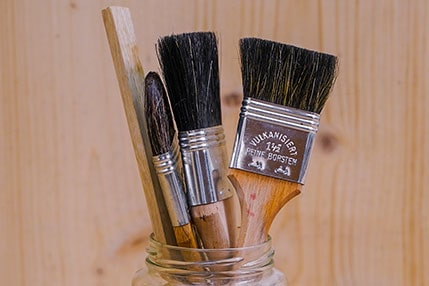
Natural hair brushes for even paint application
Which are best? Brushes with natural or synthetic bristles?
The hair ends of natural bristles – also known as China or hog bristles – divide into several fine tips that ensure particularly even colour application. Natural hair brushes should not be trimmed, but shaped into brush tips similar to how they grow on the animal. Natural bristles absorb water and swell in the process, making them more suitable for solvent-based paints such as stains and glazes than for water-based agents. When applying water-based agents, natural bristles can lose their shape and become shaggy.
Tip: Apply solvent-based agents such as chemical stains, glazes etc. with natural bristle brushes.
However, synthetic bristles now dominate the market. »Flagging« is a process that causes the bristle tips to splice open, mimicking the shape of individual natural bristles that also taper towards the tip. Compared to their natural counterparts, synthetic bristles do not absorb water and keep their shape better. Professional quality brushes are denser than inferior brushes and thus store more paint between their bristles. They also do not normally lose bristles during painting.
Tip: Brushes with synthetic bristles are ideal for water- or alcohol-diluted agents, e.g. water-based stains, low-viscosity glazes or shellac.
What are the different brush shapes?
Sash brushes are created by gathering a tuft of bristles into a round cuff and store more paint than rectangular brush types. Narrow, profiled and raised components can be painted particularly well with sash brushes of the appropriate size. Sash brushes also have a rounded tip so that they fit perfectly into round and spherical recesses. By turning the brush while painting, the agent flows out so continuously that you achieve a particularly even application.
Flat brushes are primarily intended for painting flat surfaces. They are available in any size and shape, with short or long, straight or angled handles. Used at an angle, they get the agent into tight nooks and crannies. Turned to the narrow side, flat brushes can be used to draw fine strokes and paint corners.
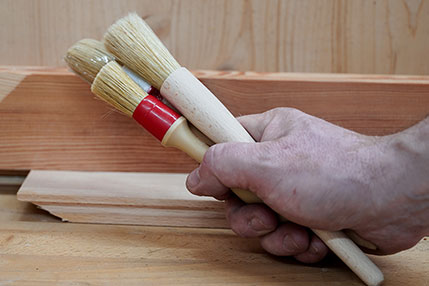
Round sash brushes store more paint than flat ones
Sponges
Surface agents can also be wiped on with an absorbent, elastic material. Sponges, cut into the appropriate size, adapt to both smooth and uneven surfaces. They adapt to corners, recesses and edges, as household sponges can be cut to any size. Sponges are also ideal for applying liquid oils and oil waxes because you can keep them fresh in a closed jar for several weeks before they dry out. Excess stain or varnish can also be removed cleanly with a sponge.
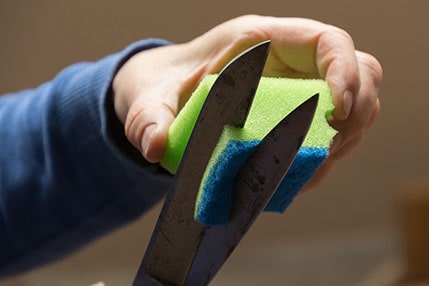
Cut the sponge to the appropriate size
Tip: Use sponges to apply slightly more viscous agents such as oil, stain and varnish.
Rags and cloths
Viscous to paste-like agents can be effectively spread with a soft cotton cloth by massaging them directly into the surface. Pasty waxes are best applied this way because of their viscosity. However, after drying, you should polish them up with a leather brush or a woollen cloth, like you do with leather shoes. This is the only way to achieve the typical fine wax shine and avoid streaks. The used cloth remains elastic if you store it in the closed wax box for the next use.
Tip: Apply pasty waxes and liquid oils with a cloth.
Paint rollers
A paint roller consists of a curved metal rod with a handle and a roller for applying the surface agent. Rollers are the right tool when it comes to treating larger, flat surfaces such as wooden floors or door leaves. Viscous, coloured agents in particular can be successfully used with them, because rollers produce a more even structure and layer thickness than brushes. If the edges of the roller are rounded off, the product can be seamlessly applied without any streaks. If you apply too much pressure during rolling, you push the surface agent in front of you like a bow wave causing the applied layer thickness to vary.
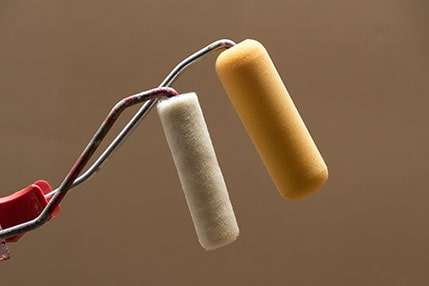
Rollers are very popular for large-scale paint application
Which roller material is better, fleece or foam?
Fleece rollers apply more of the coating agent than foam rollers. This qualifies them for working on large surfaces with fast-drying agents (e.g. acrylic varnish). Fibres, however, that are too long trap more air in the coating agent, which can lead to a wrinkled surface after drying. That is why the length of the fibres, the so-called pile length, should not exceed 4 mm when working with wood.
Foam rollers produce a finer surface due to their tiny micropores. When treating larger areas, the roller edges should be rounded at least on one edge, if not both. This prevents the edge of the roller from leaving marks when overlapping. Especially when large areas are to be treated with opaque colour, you can apply the necessary amount of coloured material more quickly with a fleece roller than with one made of foam. In corners, especially at right angles, you still have to pre-paint with a brush, because otherwise the roller will leave ring-shaped marks on the adjacent surfaces.
Tip: Rollers are ideal for the large-area application of viscous agents such as thick-layer glazes, oil waxes, or varnish
Rubbing pads
Polishing with a pad is a demanding method that requires some practice. The composition of the agent, the applied pressure, application quantity and the typical polishing movements must harmonise with each other in such a way that a smooth and glossy surface is created without any application marks. Only varnishes designated for this purpose, such as shellac or nitro-based matting agents, can be applied with a rubbing pad.
Which materials should I use for the pad?
A rubbing pad consists of an absorbent filling and a cloth stretched over it. The filling can be made of tightly pressed cotton threads, wool knitted fabric or fulled sheep's wool. All these materials store liquid well and release it evenly onto the surface to be treated during the polishing process. The surrounding cloth is ideally made of smooth cotton or linen and acts like a filter as the polishing liquid is dribbled onto the material inside.
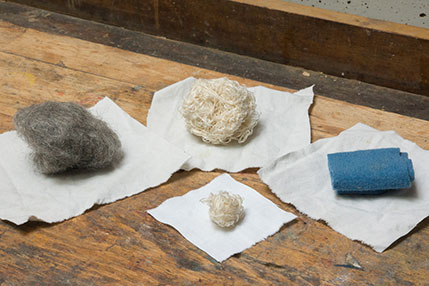
Pads filled with different fibres
What size should a rubbing pad be?
The size of the pad should correspond to the area to be treated. With sizes ranging from one to two centimetres to about six to seven centimetres, polishing is easy. The small one is intended for corners and narrow recesses that cannot be reached with a larger one. It is advisable to make the difficult corners and recesses shine first, before you start polishing the easily accessible areas in order to achieve the desired, evenly radiant shine without visible application marks.
Spray guns
Spray guns are designed for the application of varnishes and emulsion paints. The necessary pressure is generated either by a compressor or a pump, which presses the spray material through a fine nozzle so that it hits the surface to be coated in a fine atomised form. Spraying lacquers is a wet-on-wet process, i.e. you have to apply enough surface agent that the individual particles can flow into each other and thus create a closed film.
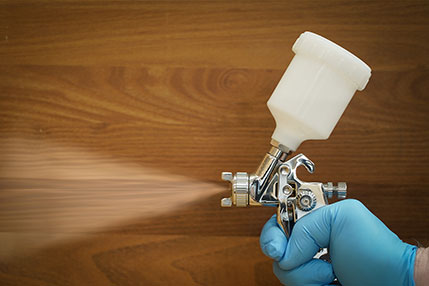
A spray gun always needs an appropriate compressor
Tip: The spraying process is well suited to all types of paint.

